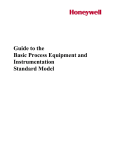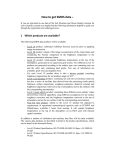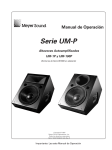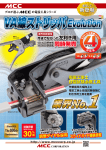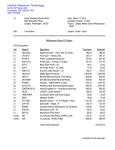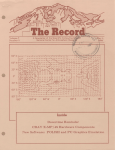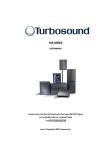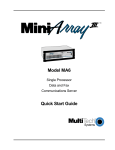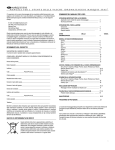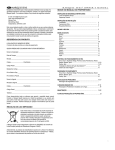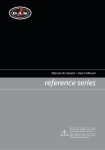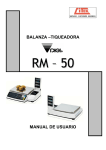Download ARRAY/AMS SERIES USER`S MANUAL
Transcript
ARRAY/AMS SERIES USER’S MANUAL Array and AMS series User’s Manual 1 INTRODUCTION ................................................................................................................ 4 2 SAFETY............................................................................................................................ 5 3 ARRAY SERIES FEATURES .................................................................................................. 7 4 SYSTEM’S FEATURES......................................................................................................... 8 5 GENERAL SETUP INSTRUCTIONS ........................................................................................ 9 5.1 Passive Box ................................................................................................................................9 5.1.1 Speaker connection ................................................................................................. 9 5.1.2 Amplifier selection ................................................................................................. 10 5.1.3 Array Series and DPA-28X ...................................................................................... 10 5.1.3.1 FEATURES ...................................................................................... 10 5.1.3.2 FRONT PANEL FUNCTIONS ............................................................... 11 5.1.3.3 REAR PANEL FUNCTIONS ................................................................. 11 5.1.4 5.2 Array Series Recommended configurations. .............................................................. 12 PCC ORIGINAL SERIES............................................................................................................... 18 5.2.1 Main Features ....................................................................................................... 18 5.2.2 Pcc Original Series Software User’s Manual ............................................................... 19 5.2.2.1 INSTALLATION ............................................................................... 19 5.2.2.2 Using the PCC Controller Original Series............................................. 19 5.3 PCC ADVANCED SERIES ............................................................................................................. 28 5.3.1 Main Features ....................................................................................................... 28 5.3.2 Back Panel............................................................................................................ 28 5.3.3 Connection Diagram .............................................................................................. 31 5.3.4 Pcc Advaced Software User’s Manual........................................................................ 31 5.3.4.1 INSTALLATION ............................................................................... 31 5.3.4.2 .-USING THE PCC CONTROLLER ADVANCED SERIES ............................ 31 5.4 RIGGING .................................................................................................................................. 40 5.4.1 Safety .................................................................................................................. 40 5.4.2 Single AMS12/AMS15............................................................................................. 41 5.4.2.1 Flown Vertically .............................................................................. 41 5.4.2.2 Mounted On a wall. ......................................................................... 42 5.4.2.3 On wind stand or on SW118 ............................................................. 43 5.4.2.4 Flown Horizontally ........................................................................... 43 5.4.3 Tree or more AMS12 and AMS15 ............................................................................. 44 2/52 Array and AMS series User’s Manual 5.4.3.1 6 Flown Vertically .............................................................................. 44 5.4.4 Array and AMS Flown Horizontally. .......................................................................... 45 5.4.5 Array/AMS series Ground Stack............................................................................... 48 5.4.6 LA312 RIGGING USING HV-312 .............................................................................. 50 Contact ......................................................................................................................... 52 3/52 Array and AMS series User’s Manual 1 INTRODUCTION Thanks for purchasing TECNARE. This product comprises the best quality designed to offer a professional use for many years. Array series represent the highest professional approach to large and medium venues sound reinforcements, where the best standards are to be achieved. Common characteristics to all models are: • Multiply Birch plywood enclosures. • Highest quality speaker standards. • Weather proof protection, both in speakers components and enclosures. • Very high power capacity. • Proprietary wave guide design. • Hi-fi quality speaker response. Active PCC advanced technology versions: Self-powered systems of high efficiency and low weight. Systems individually DSP controlled by software in real time. Graphical Equalizer of 30 bands by acoustic box. Parametric Equalizer of 10 bands by acoustic box. Individual control of gain, solo and mute. Individual Crossover of four bands Linkwitz Riley of 24dB/octave. Individual Compressor-Limiter by band. Variable delay on each band of up to 4 ms to adjust acoustic centers. Communication network able to operate, in real time, with up to 64 boxes 4/52 Array and AMS series User’s Manual 2 SAFETY Some terminals carry electrical current of sufficient magnitude to constitute a risk of electric shock. Use only commercially-available high-quality speaker cables 2. KEEP THESE INSTRUCTIONS The safety and operating instructions with ¼” TS plugs pre-installed. All other should be retained for future reference. installation 3. HEED ALL WARNINGS or modification should be performed only by qualified personnel. This symbol, appears, alerts presence of wherever you to All warnings on the product and in the it the ininsulated operating instructions should be adhered to. 4. FOLLOW ALL INSTRUCTIONS dangerous voltage inside the enclosure – All voltage should be followed. that may be sufficient to constitute a risk of shock. This symbol, operating and use of instructions 5. DO NOT USE THIS APPARATUS wherever it NEAR WATER appears, alerts you to important Do not use the product near water. For operating example, instructions in and the maintenance accompanying literature. Please read the manual near a bathtub, washbowl, kitchen sink, or laundry tub, in a wet basement, or near a swimming pool, and To reduce the risk of electric the like. shock, do not remove the top 6. CLEAN ONLY WITH DRY CLOTH cover (or the rear section). No Unplug the unit from the wall outlet before user cleaning. Do not use liquid cleaners or serviceable parts inside. Refer servicing to qualified personnel aerosol cleaners. Use a damp cloth for These service instructions are for cleaning. use 7. DO NOT BLOCK ANY VENTILATION by qualified service personnel only. To reduce the OPENINGS risk of electric shock do not Slots and openings in the cabinet back or perform any servicing other than that bottom are provided for ventilation, to contained in the operation instructions. ensure reliable operation of the limit and Repairs have to be performed by qualified to protect it from overheating. These service personnel. openings must not be blocked or covered. 1. READ THESE INSTRUCTIONS The openings should never be blocked by All the safety and operating instructions placing the product on a bed, sofa, rug, or should be read before the product is similar surface. This product should never operated. be placed near or over a radiator or heat 5/52 Array and AMS series User’s Manual source. This product should not be placed Do not place this unit on an unstable cart, in stand, tripod, bracket, or table. The unit a built-in installation such as a bookcase or rack unless proper ventilation may is someone, and serious damage to the provided or the manufacture's fall, causing serious injury to instructions have been adhered to. appliance. A unit and cart combination 8. DO NOT INSTALL NEAR ANY HEAT should be moved with care. SOURCES 13. This Product should be situated away from DURING heat sources such as radiators, stoves, or WHEN UNUSED FOR LONG PERIODS other products (including amplifiers) that OF TIME. produces heat. For added protection for this unit during a 9. DO NOT PURPOSE DEFEAT OF THE THE SAFETY POLARIZED OR UNPLUG THIS LIGHTNING lightning storm, or APPARATUS STORMS when it is OR left unattended and unused for long periods of GROUNDING-TYPE PLUG time, unplug it from the wall outlet and A Polarized plug has two blades with one disconnect the antenna or cable system. wider than the other. A grounding-type This will prevent damage to the unit due plug has two blades and a third grounding to lightning and power line surges. prong. The wide blade or the third prongs 14. are QUALIFIED provided for your safety. If the REFER ALL SERVICING SERVICE TO PERSONNEL. provided plug does not fit into your outlet, SERVICING IS REQUIRED WHEN THE consult an electrician for replacement of APPARATUS HAS BEEN DAMAGED IN the obsolete outlet. ANYWAY, SUCH AS WHEN THE POWER 10. PROTECT THE POWER CORD FROM SUPPLY CORD OR PLUG IS DAMAGED, BEING LIQUID WALKED ON PARTICULARLY OR AT CONVENIENCE PINCHED PLUGS, RECEPTACLES, AND HAS OBJECTS HAVE APPARATUS, THE POINT WHERE THEY EXIT FROM BEEN THE APPARATUS. MOISTURE, 11. ONLY ACCESSORIES USE ATTACHMENTS SPECIFIED BY THE BEEN SPILLED FALLEN THE OR INTO THE APPARATUS HAS EXPOSED TO DOES NOT RAIN OR OPERATE NORMALLY, OR HAS BEEN FROPPED. 15. WARNING: TO REDUCE THE RISK MANUFACTURER. OF FIRE OR ELECTRIC SHOCK, DO 12. USE ONLY WITH CART, STAND, NOT EXPOSE THIS APPARATUS TO TRIPOD, RAIN OR MOISTURE. BRACKET, OR TABLE SPECIFIED BY THE MANUFACTURER, 16. OR EXPOSED SOLD WITH THE APPARATUS. APPARATUS TO SHALL NOT DRIPPING BE OR WHEN A CART IS USED, USE CAUTION SPLASHING AND NO OBJECTS FILLED WHEN WITH LIQUIDS, SHALL BE PLACED ON MOVING THE CART/APPARATUS TO AVOID INJURY THE APPARATUS. FROM TIP-OVER. 6/52 Array and AMS series User’s Manual 3 ARRAY SERIES FEATURES The Tecnare integrated Array line Series of is a fully provide the best flexibility, which is a very self-powered DSP important factor when multiple zones controlle loudspeakers that merge the within the array are required. singular advantages o array technology, Array Series products also incorporate with the application of computer digital extra hardware for rigging and stacking as management a standard. audio benefits to professional reinforcements. With this revolutionary technique the entire concept of an array box is completely replaced by the idea that each array element changes to be an active device, namely a PCC speaker, controlled with a small laptop via software. A standard PCC speaker houses Applications: • Live Music • Dance Clubs • Theatre and corporate events. • Houses of workship • Touring one or more module amps and a DSP processor. All these PCC speakers are linked by a network through a Main Characteristics: USB • interface to the laptop. simple, fast and safe rigging. Once connected, we can control in real time the parameters of each speaker such as volume, parametric graphic • rigid construction. parametric equalisation, crossover, internal delays, • Durawound recall of presets, mute, transfer spectrum protected analysis, real time analyzer, spectrum permanent applications are designed installation where for and even both • specially and treated ensure the consistency required to obtain acoustically transparent reticulated foam. reinforcement professionals solutions to arrays coating. Powder coated perforated steel grid with Array Series are engineered to offer sound controlled weatherized One recessed carrying handle. • meet almost any challenge. 16mm or 18mm birch plywood. Durawood coverage, required. DSP with finish Finished in blck semimatt textured touring intelligibility, and high SPL levels are Self-powered texture grills. control, phase check, and more! Series Weatherized finish is provided, as the cabinet is coated with rugged compressor-limiters, check test, save and Array Enclosures made with the latest techniques ensuring a perfect and equalisation, equalisation, Built in proprietary hardware for • Max SPL: Up to 136dB Continuous. • Nominal dispersion up to 90ºH x 8ºV the benefits of line array technology and 7/52 Array and AMS series User’s Manual 4 SYSTEM’S FEATURES Calculated max SPL: 136dB Continuous LA 208 Power Handling: Frequency Response: 78Hz-18kHz ±4dB Nominal Dispersion: 85ºH x 10ºV @ -6dB Impedance: 8 Ohm Net 480W nominal 28.6kg selfpowered (width) x 740 weight: 86 kg selfpowered Pcc Components: Dimensions(HxWxD): 610x458x262mm weight: hetight)x1245 version. 900W continuous Net Dimensions(HxWxD): 410 (front H)x310 (depth)mm Calculated max SPL: 129dB Continuous Power Handling: 2400W continuous (rear Sensitivity: 99dB (1w/1m) 1500W nominal Pcc version. Low:2x12”LF driver band pass horn loaded Mid: 1x12”HF passed corrected High: 2x1.5” compression driver attached Components: 2x8” LF driver, 1x1.4”HF to a proprietary waveguide device. exit compression driver MINIARRAY LA 122 Frequency Response: 85Hz-18kHz ±4dB Frequency Response: 69Hz-18kHz ±4dB Nominal Dispersion: 85ºH x 8ºV @ -6dB Impedance: 8 Ohm Impedance: 8 Ohm Sensitivity: 96dB (1w/1m) Sensitivity: 100dB (1w/1m) Calculated max SPL: 128dB Continuous Power Handling: Nominal Dispersion: 85ºH x 8ºV @ -6dB Calculated max SPL: 120dB Continuous Power Handling: 600W nominal 1100W continuous Dimensions(HxWxD): 410x600x430mm Net weight: 40kg selfpowered Pcc version. Components: 1x12” LF driver, 2x15”HF 250W nominal 480W continuous Dimensions(HxWxD): 232x543x462mm Net weight: 27kg selfpowered Pcc version. Components: 2x6 1/2” LF driver, 1x15”HF driver on a proprietary waveguide device. driver on a proprietary waveguide device. AMS 12 LA 312 Frequency Response: 48Hz-19kHz ±4dB Frequency Response: 58Hz-19kHz ±4dB 42Hz-19kHz ±4dB (6 elements) Nominal Dispersion: 90ºH x 8ºV @ -6dB Impedance: 4 Ohm low, 8 Ohm mid, 8 Ohm high. Sensitivity: 105dB (1w/1m) Nominal Dispersion: 90ºH x 30ºV @ -6dB Impedance: 8 Ohm Sensitivity: 103dB (1w/1m) Calculated max SPL: 132dB Continuous Power Handling: 580W nominal Dimensions(HxWxD): 705x395x420mm Net weight: 30kg selfpowered Pcc version. 8/52 Array and AMS series User’s Manual Components: 1x12” LF driver, 1x1.4”HF driver on a rotary constant Q horn 5 GENERAL SETUP INSTRUCTIONS AMS 15 5.1 Passive Box Frequency Response: 42Hz-18kHz ±4dB 5.1.1 Speaker connection Nominal Dispersion: 90ºH x 40ºV @ -6dB Array series are connected with Speakon Impedance: 8 Ohm NL4 plugs except the LA312 unit, which is Sensitivity: 106dB (1w/1m) connected with Speakon NL8. Calculated max SPL: 135dB Continuous Connectors are wired as follows: Power Handling: 680W nominal Dimensions(HxWxD): 890x520x550mm Net weight: 39kg selfpowered Pcc version. Components: 1x15” LF driver, 1x1.4”HF driver on a rotary CD horn SW118M Frequency Response: 35Hz-400Hz ±4dB Speakon Connector LA312 LA122 MiniArray 1(+) 1(-) LF (+) LF(-) LF (+) LF(-) 2(+) 2(-) MF(+) MF(-) HF(+) HF(-) 3(+) 3(-) HF(+) HF(-) SW118M SW218M LF (+) LF(-) Impedance: 8 Ohm Sensitivity: 98dB (1w/1m) Calculated max SPL: 128dB Continuous Power Handling: 1000W nominal 2000W continuous Dimensions(HxWxD): 556x569x691mm Net weight: 54kg selfpowered Pcc version. Components: 1x18” LF driver. The two socket speakon pins in the box SW218V are connected in parallel within the Frequency Response: 38Hz-280Hz ±4dB enclosure, so either connector can be used Impedance: 4 Ohm to connect an amplifier or to link to an Sensitivity: 103dB (1w/1m) additional Array series or Tenare unit. Calculated max SPL: 138dB Continuous Power Handling: 2000W nominal In an exceptional way, AMS 12 and AMS 4000W continuous 15 can also work in a full range mode by Dimensions(HxWxD): 1080x580x830mm shortcutting the 1+ and 2+ pins and 1- Net weight: 85Kg selfpowered Pcc version. and 1- pins of the NL4 input speakon Components: 2x18” LF driver. connector. 9/52 Array and AMS series User’s Manual Tecnare recommends a maximum length compressor, Limiter, USB and Ethernet cable according to the section cable used. port connection. Precise frequency control is achieved with its 1 Hz resolution. [mm2] Section Impedance 1.5 2 3 4 6 8 12 16 2.5 3 4.5 6 9 12 18 24 The DPA - 28X can be controlled or 2.5 5 7.5 10 15 20 30 40 configured in real time on the front panel 8 12 16 24 32 48 64 using the previously stored presets or with the intuitive PC software via the USB or Ethernet interface. The Ethernet port allows controlling the device from a long distance using just an Internet connection. 5.1.3.1 FEATURES 5.1.2 Amplifier selection Tecnare recommends amplifiers in agreement with the table below: • 2 Input and 8 Outputs. • 64 Bits floating point DSP • High performance 24-bit A/D Converters Unit Conf. 2xSW118M 8xLA312 + 6xSW218M 8xLA122 + 4xSW118 12xLA122 + 8xSW118 12xMiniArray + 4xSW118 1xMA2400 8xMCH4700 4xMCH4700 4xMCH4700 2xMCH4700 • 1 Hz Frequency Resolution • Storage • output digital loudspeaker management system designed for the touring or fixed latest in available technology is utilized with 64-bit floating point processors and Analogue noise and distortion induced by truncation errors of the commonly used 24-bit fixed- parameters A include complete I/O set levels, of delay, polarity, 8 bands of parametric EQ per channel, multiple crossover Unlimited number of presets via Uploading of 10 collection presets USB port connection. • Ethernet port connection • 30 bands Input graphic equalizer. • 8 selections, bands Output Parametric equalizer per output channel • 4 ways configurable Crossover • Main Delay • Input and output Compressor and Converters. The high-bit DSP prevents devices. program • sound installation markets. The absolute point 10 in one step via software The DPA 28X is a complete 2 input - 8 24-bit to software 5.1.3 Array Series and DPA-28X performance up setups • high of Limiter • Configurable Clock • Noise Generator • Sound Analyzer • Phase inverter per band • Mute • Via adjustable delay 10/52 Array and AMS series User’s Manual 5.1.3.2 FRONT PANEL FUNCTIONS 3 1 2 6 7 5.1.3.3 REAR PANEL FUNCTIONS 8 5 4 9 1 1.-LCD Screen CH-A: Show all the 2 3 4 1.- Main Power: Connects via a standard necessary information to control de unit IEC socket. A compatible power cord is supplied with the unit. The voltage input is 1 I BZ A6 P 01 I D:01 3 d efau lt either 115VAC or 230VAC and is clearly specified on the unit. Voltage requirement 2 has to be stated upon ordering. 1.- Unit name 2, 3.- XLR input and outputs: Separate 3- 2.-Shows the preset number and pin XLR connectors are provided for each identification. audio input 3.- ID of the Unit. output and stage output. employs The the device's balanced 2.- Rotary thumb wheel CH-A: Controls impedance topology. All I/O connectors the presets. To select the desire preset, have pin 1 as ground (shield), pin 2 as + press the wheel. and pin 3 as – 3.- On / SIGNAL / CLIP led CH-A: When 4.- USB connectos: USB connector per On indicate the unit is On, Signal at the channel for PC connection. input and the input level is above the device’s maximum headroom respectively. Note: Please refer to section for further 4.- information. LCD Screen CH-A: Show all the necessary information to control de unit 5.- Rotary thumb wheel CH-A: Allows you to switch between presets. To select the desire preset, press the wheel. 6.- On / SIGNAL / CLIP led CH-A: When On indicates the unit is On, Signal at the input and the input level is above the device’s maximum headroom respectively. 7, 8.- Ethernet connector: Standard RJ-45 female socket. 9.- Power switch: Controls power On/Off. 11/52 Array and AMS series User’s Manual 5.1.4 Array Series Recommended configurations. 12/52 Array and AMS series User’s Manual 13/52 Array and AMS series User’s Manual 14/52 Array and AMS series User’s Manual 15/52 Array and AMS series User’s Manual 16/52 Array and AMS series User’s Manual 17/52 Array and AMS series User’s Manual 5.2 PCC ORIGINAL SERIES 5.2.1 Main Features • Input graphic eq. • Input parametric eq ( 10 bands). • 4 band crossover. • Gain control. • Mute control. • Check test. • Buit in Analyzer (impulse, transfer, rta, etc..). • Real time control. • Presets storage in the PC. • Grouping. • Acoustic center control, between bands. • Compressor / Limiter in each band. Original Series 18/52 Array and AMS series User’s Manual 5.2.2 Pcc Original Series Software In order to modify the inventory file according with the user configuration, User’s Manual please edit the mentioned file using a text editor. 5.2.2.1 INSTALLATION 1.- Click on Setup.exe icon 2.- Follow the wizard EDITING INVENTARY FILE. instruction (for default installation you can press NEXT Once in the text editor, add and/or erase until the end) the serial numbers according with the * The estimated time required for first following instructions: installation is about 1 minute. * If asked by the wizard, restart the computer 3.- Connect the unit to the PC using the provided USB cable. 4.- Copy serfile.ccc and default.inv files from the installation CD to c: \program files \PCCcontrol \usbsetup. NOTE: DIRECTORY ROOT CAN VARY DEPENDING ON THE CONFIGURATION OF THE COMPUTER OF THE USER CASE. • The serial numbers must always have 5.2.2.2 Using the PCC Controller Original Series. four digits. • No spaces between numbers, not even STARTING COMMUNICATION. at the end of the list is required. Click on the PCC icon Once selected the inventory file, the software begins, by defect, in the Network screen: In the previous window, please select the inventory file. 19/52 Array and AMS series User’s Manual The serial numbers of the boxes listed in MIXER SCREEN. the inventory file will appear in the left By pressing F2 key you will open the column of the screen. mixer screen where you can find as many Open the communication port by clicking faders in yellow colour as boxes connected to the network. the next button: Once opened, it will appear a magnifying glass icon. Pressing this icon, the system will start a communication test. Please check all the boxes connected to the computer are responding correctly by checking either the alternative numbers shown in the back part of each unit or the front red light When a box is selected, the fader will turn from yellow to red. EDITING CHANEL PARAMETERS. flashes. CHANNEL LABEL BOX TEST MUTE GRAPHIC EQUALIZATION BOX ID NUMBER ID GROUP ID Click on “OK. All the devices are responding” CHANNEL FADER At this point the following window will appear, where you can find all the boxes connected to the network by series. ATENUATION LEVEL 20/52 Array and AMS series User’s Manual • Channel label: It allows assigning a name to each box. • Box It Fader: will attenuate or enhancement the level of the box. Test: When pressing it will emmit a signal composed by a pink noise to each GRAPHIC EQUALIZER. one of the crossover bands of the box. The purpose of this test, is to verify that all the components are in good condition. Mute: It silences the box. Graphical Equalization: It is acceded to the graphical equalizer of 30 bands of the box. (See graphical EQ) Box ID: It shows the Box ID. This value can´t be modified by the user. Number ID: It is a consecutive number assigned to each box according to the order of the boxes in the inventory file. Group ID: With the purpose of being able to process a set of boxes at the same time, exists the possibility of grouping the channels of the mixer. The graphical equalizer has the following technical characteristics per box: - 30 bands of 1/3 of octave from 20Hz to 16kHz - Enhancement/ Attenuation of +15dB/ 15dB - Function to keep and to load different equalizations - Bypass The box ID information shows the identification number of the box. In order to assign a number of group, right click on group ID, assigning the MIXER GLOBAL FUNCTION same number to all boxes that will form this group. You can switch on and off this PAGE SELECTOR PAGE NUMBER LOAD/SAVELABELS GROUPS ON/OFF feature by clicking “Groups Active” in the right inferior parto of the screen. Once activated, all the boxes in the same group will vary their parameters when GLOBAL MUTE EDIT MODE TEST GROUP/GLOBAL ANALYZER EXIT ID NUMBER varying anyone of the parameters of one of the boxes of the group. Have in mind that the system will assign the same configuration that has the box located to the vary left of the boxes, saving this configuration in the memory of the box. Page Number: With PCC Technology software it is possible to make the control of up to 64 boxes. In order to have an operational control, these 64 boxes are in four pages of 12 channels each. This parameter indicates the number of page. 21/52 Array and AMS series User’s Manual Page selector: Changes the showed correspond with the numbers that the page. system Load / Save labels: In order to make remember that the inventory file can agile the process of identification of boxes, contain serial numbers that really do not it is possible to save the labels of all the exist in the work network. channels later to be loaded in another has not detected. Let us Like in the mixer screen the box session. that is selected is noticeable with a point Groups on/off: It switches on/off the of red colour. global function group. Global Mute: It silences all the connected boxes to the network. Analyzer: with the activation of this button, one will enter the analyzer window. AUDIO ANALYZER. Edit mode: In User mode it is possible to make modifications in all the parameters of the box except in cut-off frequency of the crossover filters, and the delay of each band. In Service mode the user is allowed In the left part of the screen are all the functions that can be used: to accede to the expert service, an access It sends a flag test to all the boxes, key is due to introduce, to select "service" to verify that communication is being done and to press "Validate". properly. Group / Global Test: it tests that the communication is working properly. It saves the data of configuration of the active box (red) to a file. When ID Number: It visualizes the number of identification of the active box ( fader in red) making this action is necessary to consider that this configuration is stored automatically in the box, in such a way Exit: Exit the software that when returning to switch on it will do it with this configuration. NETWORK SCREEN. It loads a configuration file to the At the screen Network, the different boxes are located in columns according to the series to which they belong. The serial numbers that appear Network are the in the contained in the that really are connected to the network those that they remain box stores in its memory this configuration. column inventory file, being in green colour those and selected box. As in the previous case the in blue It updates the present configuration in the internal memory of the box, in such a way that it is stored in its non-volatile memory. 22/52 Array and AMS series User’s Manual NOTE: THE EXPLAINED REMAINING IN THE ICONS SECTION HAVE BEGINNING BEEN The graph that appears contains two lines. THE The red one corresponds to the activated COMMUNICATION band, and the green line corresponds with the sum of the 10 bands of the equalizer PARAMETRIC EQUALIZER. (global equalization). In order to accede to the parametric equalizer, select "Par. EQ " at the window" Pcc Box Controller ". It is necessary to consider that each one of the boxes has it’s own parametric equalizer, reason why it is necessary to assure that the box to which is wanted to apply a parametric equalization is selected The model and number of the box being (in red). equalizer appears in the right superior part of the window. In order to equalize, select the desired band by clicking the band selector. The central frequency of the band can be entered in written to modify or also you can drag with the mouse in the graph the curve of red colour. Like with the frequency, the enhancement or wished attenuation can be written or can be modified in the graph with the Technical characteristics: mouse. In order to select the bandwidth • 10 parametric Bands. to work, press with the right button of the • Selector of frequency from 20Hz to mouse in window "Q" and select the 20kHz. desired Q. • Enhancement/Attenuation of +15dB/ -15dB by band. • Factor of quality, Q: Expressed in octaves, from 0.1 to 1 octave. • Silence (Mute) • Activation/ Deactivation of equalization (Bypass) • Generating of pink noise. Way of operation: 23/52 Array and AMS series User’s Manual CROSSOVER. addition a phase reverse and mute facilities per band. • Adjustable delay by band from 0 to 4ms to fit the acoustic centers of the different elements from the box. As commented in section 2,2 (GLOBAL FUNCTIONS Of the MIXER) to be able to modify the parameters of this window it is necessary to enter mode service introducing the user key. This window consists of four filters crossover, a compressor/ limiter and an adjustable delay in time or distance by band. RESPONSE. Technical Characteristics: • Adjustable superior and inferior Cut-off frequencies in all the rank of frequency by band. The slope is of 24 dB/octave in Linkwitz-Riley in the box equalization simultaneous referring can way be to graphical visualized with in parametric equalization and crossover. way. • With this screen, all the processing made Variable Control of adjustable gain from -24dB to +5dB with the fader of the mouse in the screen response. • Limiter by band with threshold control, time of attack and release. The threshold can be modified entering the values manually or moving the faders at the right of the window. The limiter has in 24/52 Array and AMS series User’s Manual By clicking the buttons located in the SETUP SCREEN. inferior part of the screen, it is possible to hide and show the different crossover bands as well as the different equalization made. AUDIO ANALYZER. The system introduces a powerful audio analyzer, to which it is acceded by clicking the analyzing key of the audio mixer. With this tool, the sound engineer can make The measurer VU is activated by pressing the following analyses: impulse response, the icon VU: It allows simultaneously to transference function, spectrum analyzer, visualize the signal of reference and the phase response and can even obtain the input signal . polar plot of the box. In the right superior part is the generator of signals, in which it is possible to select This screen contains several folders in the the type of signal (sinusoidal, square, pink superior part with the purpose of being noise, white noise, etc.), frequency of the able to visualize all the possible analyses signal, time of the pulse, interval of the in separated windows. All these windows pulse and level of output. have a common zone of configuration of analysis located in the inferior part of the This screen also have adjustment of delay screen. of the different bands which can be obtained with the impulse response. FFT W INDOW SIZE ANALISYS KIND OF ANALISYS W INDOW AVERAGE MODE AVERAGE SMOOTH IMPULSE RESPONSE. START PRINT With this screen the answer of the impulse of a certain room can be obtained. 25/52 Array and AMS series User’s Manual processing curve made to the box selected Also the existing delay between the at the network or mixer screen, whereas different speakers of the box can be the green line shows the function of obtained. transference of the box. In order to make this process the system enables markers with the purpose of being able to visualize in a fast and effective way the existing delay between the emission of the impulse and the reception of the same one by an error microphone. In this way it is possible to obtain the retardations relative to each band. REAL TIME SPECTRUM ANALYZER RTA. The system allows in addition to make analysis in frequency with a Real Time Analyzer. It is possible in addition simultaneously to visualize the spectral analysis of the signal of reference and the signal of entrance (microphone). TRANSFER FUNCTION. With the use of this screen, the system calculates the transfer function of the system, that is to say, the difference between the signal from the input of the box to the taking of the acoustic signal by a measurement microphone. In the inferior part of screen, are different functions as adjustment from inferior and superior frequency, capture curve snapshot (show peak), erase of captured curve (reset peak) and show/hide of the signals reference and input independently. A very important function that contains this screen is the possibility of visualizing and modifying in real time, using the mouse, the (represented in graphical the figure equalizer by white triangles) of any of the boxes whose graphic eq has been selected at the mixer screen. The yellow line corresponds to the 26/52 Array and AMS series User’s Manual PHASE RESPONSE. The screen that is in the superior part allows to make the measurement of the phase response of a certain box, the functions that are in this window are similar to the ones found in previous chapters. POLAR DIAGRAM. With this function, it is possible to obtain the polar diagram of the box at different frequencies. 27/52 Array and AMS series User’s Manual 5.3 PCC ADVANCED SERIES PCC Advanced series allows control in real time the parameters of each speaker individually or grouped as we decide, factors such as volume, graphic equalisation, parametric equalisation, crossover, box delay, clock settings, internal delays, compressor-limiters, check test, save and recall of presets, mute, transfer spectrum analysis, real time analyzer spectrum control, phase check… 5.3.1 Main Features • Ethernet control. • 10 built in presets without the use of the software. • Unlimited presets storage in the PC. • Input graphic eq. • Parametric eq on each band ( 4 x 8 bands). • General Delay. • 4 band crossover. • Gain control. • Mute control. • Check test. • Buit in Analyzer. • Real time control. • Presets storage in the PC. • Grouping. • Acoustic center control, between bands. • Compressor / limiter in each output band. • Input compressor / limiter. • Clock set 5.3.2 Back Panel Advanced Series: 28/52 Array and AMS series User’s Manual 29/52 Array and AMS series User’s Manual Cobranet Series: 30/52 Array and AMS series User’s Manual 5.3.3 Connection Diagram 5.3.4 Pcc Advaced Software 5.3.4.2 .-USING THE PCC CONTROLLER ADVANCED SERIES User’s Manual The Tecnare PCC Controller advanced 5.3.4.1 INSTALLATION series software application provides real- 1.- Click on Pcc12G_Setup.exe icon time control and configuration editing for 2.- Follow the wizard instruction (for the DPA-28X using a laptop or other PC- default installation you can press NEXT compatible computer. until the end) In * The estimated time required for first control over each individual input channel: installation is about 1 minute. Gain, * If asked by the wizard, restart the delay, and over each individual output computer channel: Crossover, 8 bands parametric 3.- Connect the unit to the PC using the EQ, phase inverter, mute, and delay. In provided USB cable. addition, addition, Graphic the the EQ, application provides Compressor, application main provides a powerful real time analyzer with pink noise generator capability. Changes made in the PC software are immediately executed in the DPA-28X. 31/52 Array and AMS series User’s Manual • To start the application click on the PCC Icon on your desktop Save Set: Save the current set of 10 presets to a file. • Exit: Exit the application It will appear a screen as is in the CONNECT following image: On line: Connects the computer to the unit. DELAY UNITS • ms • meter • feet NETWORK WINDOW Open the Connect dropdown list and select On Line, this will connect your unit following information is shown at the to your PC. The user When the PC is connected to the unit, the interface is divided into 4 upper left corner of the screen. sections: Temperature • Menu Bar • Network window • Input section • Output section Limiter Signal MENU BAR Temperature: It shows the temperature of each output channel. Limiter: The limiter light show up when The following menus are available in the the audio limiter is acting. Menu Bar at the top of the screen Signal Indicator: When lighting a input signal is present. FILE • Load Preset: Click this option to Load an existing preset from your computer • Save Preset: Save the current preset to a file • Load Set: Click this option to Load a Set of 10 preset from your computer 32/52 Array and AMS series User’s Manual The output level is controlled by the fader INPUT SECTION control. This section contains the following INPUT LEVEL modules: • Unit ID and grouping. • Signal Generator • Input Level • Input Compressor • General Setup • 30 bands Graphic equalizer UNIT ID AND GROUPING It shows the units information connected Main delay in ms, meters or feet can be to the PC, the active one is the one on adjusted in this section. The input level is Red. Double click to activate the unit. adjusted by the fader control, it provides signal and clipping indicators. Unit Group Unit ID By clicking on the group ID box, the user will be able to assign each unit to a group. SIGNAL GENERATOR By selecting active in the dropdown list, a pink noise signal is generated by the 8 output channels. 33/52 Array and AMS series User’s Manual signal falls below the threshold. It INPUT COMPRESSOR is calibrated in milliseconds, with a range from 10 ms to 2500 ms (2.5 seconds). • Ratio: This determines the change in output level as a function of the change in input level, once the threshold has been exceeded. It is calibrated in decibels, with a range from 1.2:1 (off) to 30:1. The input compressor has four controls: Attack, Release, Threshold and GENERAL SETUP Ratio. Click on the dropdown list to adjust each parameter. Click the Bypass button to turn it off. About Compression: A compressor is used to reduce or limit transient peaks in a signal. As the input level to the compressor increases, the output level increases linearly until the threshold point is reached. After that point, the output level no longer increases linearly, but increases at a reduced rate that is The following controls are available in the general Setup module: determined by the ratio setting. • • Presets Threshold: This control determines • RTC Setup the level at which the compressor • Analyzer begins to act on the incoming • Network signal. It is calibrated in decibels, • Pcc LAN Port with a range from –-40.0 dBu to 17 • Internet Router IP dBu. • PRESETS Attack: This determines how fast the compressor reacts once the threshold has been exceeded. It is calibrated in milliseconds, with a By pulling down the Select Preset dropdown list, 10 different preset saved in the unit can be selected. range from 1 ms to90 ms. • Release: This determines how fast the compressor turns off once the 34/52 Array and AMS series User’s Manual Changes made in the PC software are • Display: Allows the user to immediately executed in the DPA-28X, show/hide the input and reference and stored in the selected preset. signals. A Preset name can also be stored. RTC SETUP By clicking Ctrl+Alt+P the RTC Setup module will be shown. This module is a time counter clock that • Parameters: • Mode: The audio analyzer allows allows the user to control when and how the the user to work on four different unit has been working. modes: To Unlock this feature, click on RTC Setup, send to Tecnare the code shown on the screen, and introduce the unlock code you will have back from Tecnare. • o Spectrum Analyzer o Transfer Function o Phase Response o Impulse Response Average: Eight different time average can be selected: 1, 5, 10, ANALYZER 20, 30, 50, 80 and 120. This toggles the audio Analyzer window • open and closed. Window: None, Signal Windowing Hamming, by Triangular, Hanning and Blackman • Smooth: Is the frequency average. None, 1/3, 1/6, 1/12, 1/24 Octave. • Input and Output: Allows the user to choose the PC input and output device. The following information is available in this window: 35/52 Array and AMS series User’s Manual • Pink noise: Enable the pink noise generator. Note that the Pink noise can only be enabled when the analyzer is turned Off. TRANSFER FUNCTION It shows the systems transfer function, meaning the difference between the signal from the output of the DPA-28X to the microphone input signal. • Buttons: o On: Turn on and off the analyzer o Close: Close the analyzer window o Fade: It makes the window analyzer 50% transparent, so the user can see the window behind. PHASE RESPONSE It allows the user to analyze the phase response of an installation SPECTRUM ANALYZER This feature allows the user to visualize the spectral components either of the input signal (given by a microphone connected to the PC) or the reference signal (output) it is also possible visualize both signal simultaneously. to IMPULSE RESPONSE This tool provide the spectrum impulse response of a certain room. 36/52 Array and AMS series User’s Manual NETWORK This button toggles the network window open and closed. (Refer to 2.3 for more information) 37/52 Array and AMS series User’s Manual GRAPHIC EQUALIZER Click the ON button to turn the Graphic EQ on and off Click and drag on the slider fader to adjust the equalization from -15dB to +15dB. Three different kinds of filters can be selected: OUTPUT SECTION The user can manage the output section by clicking on Out A-B and Out C-D buttons. • Bessel • Butterworth • L-R The order of the filter can be selected by pulling down the Bypass dropdown list, Second Order filter (12dB/Octave) and Fourth Order filter (24dB/Octave) are available. Filter cut-off Frequency ranges from 20 to 20,000Hz in 1Hz steps This section contains the following modules: PARAMETRIC EQ Eight bands parametric EQ can be opened by clicking on the Equalizer Out X button. • Crossover • Graphic EQ • Limiter • Level • Delay • Phase inverter • Mute CROSSOVER Four different settings can be adjusted by This section contains two crossover filters the user per band. per output. • Type: The user can select Hi Pass, Low Pass or band filter 38/52 Array and AMS series User’s Manual • Frequency: Ranges from 20 to LIMITER 20,000Hz in 1Hz steps • Bandwidth: Ranges from 0.1 to 2 Octaves • Level: Ranges from -25dB to 25dB • Threshold: controls The are THRESHOLD continuously adjustable from -40dBu (maximum limiting) to 17dBu • Bypass: Turn the module in bypass mode. • Attack: Ranges from 0.1 to 90ms • Release: Ranges from 2x to 32x The user can also modify the equalization (Frequency and level) by clicking and dragging the grey points on the screen, LEVEL/DELAY • Level: The output level can be the selected band will turn from red to adjusted from -60dB to 12dB, unit orange. gain is at the 0dB position. To copy the desire equalization to other • Delay: Ranges from 0 to 10 ms output just click on Copy button, go to the • Phase inverter. desire output parametric EQ and click on • Mute. the paste button. 39/52 Array and AMS series User’s Manual 5.4 RIGGING 5.4.1 Safety Flown Systems • Installation and set up must be carried out by qualified personal. • Inspect the all the rigging components for damage before assembly. Do not use damaged parts. Contact your supplier for replacements. • Ensure that motor hoists, hoist control systems and ancillary rigging components are currently certified as safe and that they pass a visual inspection prior to use. • Ensure the work area is isolated from public access. • Do not leave the system unattended during the installation process. • Do not leave any object on top of the system. It may fall when the system is flown and is likely to cause injury. • Secondary safety steels must be installed once the system has been flown to the operating height. • Ensure that the system is secure and prevented from pivoting around the motor hoist. • NEVER use other item than Tecnare accessories. • When flying outdoor systems ensure that the system is not exposed to excessive wind or snow loads and is protected from rainfall. • When deploying Tecnare Systems always wear protective headwear, footwear and eye protection • Ensure that all local and National regulations regarding the safety and operation of flying equipment are understood and adhered to. Ground Stacking • Always employ safe lifting procedures and never attempt to build stacks without sufficient personnel and equipment. • Never allow anyone to climb onto a ground stacked PA system. • If the stage surface slopes, ensure that the system is prevented from sliding forwards due to vibration. • For outdoor systems ensure that the system is protected from wind forces which might cause the ground stack or become unstable. • Apply the same attention to all safety matters when de-stacking systems. 40/52 Array and AMS series User’s Manual Accessories are: • • • • • HV-12/M15 • HS-12/M15 • HV-208 • HS-208 FBV_12/FBV_M15 FBH_12/FBH_M15 CV-12/M15 LP_12/M15 5.4.2 Single AMS12/AMS15 • L_12/M15 5.4.2.1 Flown Vertically Items required: • 1x Flying bar for AMS12 or AMS15 (FBV_12 or FBV_M15) Procedure: 41/52 Array and AMS series User’s Manual • Remove the two up-side screws from the box. • Place the FBV_12 or FBV_M15 and put the screws back. 5.4.2.2 Mounted On a wall. Items required: • LP_ 12 or LP_M15 • L_12 or L_M15 Procedure: • Remove the two up-side screws from the box. • Place the LP_12 or LP_M15 and put the screws back. • Hold the L_12 or L_M15 to the wall. • Place the unit into the L_12 or L_M15, place the upper and bottom screw. 42/52 Array and AMS series User’s Manual 5.4.2.3 On wind stand or on SW118 Items required: • 1x Wind stand 5.4.2.4 Flown Horizontally Items required: • 1x Flying bar for AMS12 or AMS15 (FBH_12 or FBH_M15) Procedure: • Remove the two up-side screws from the box. • Place the FBH_12 or FBH_M15 and put the screws back. 43/52 Array and AMS series User’s Manual 5.4.3 Tree or more AMS12 and AMS15 5.4.3.1 Flown Vertically Items required: • Bumper (CV-12/15) • Nx FBV_12/M15 • 4Nx Pin Locks Procedure: • Align the boxes with the desire angle using the pin locks. • Remove the two up-side screws from each box. • Place the FBV_12 or FBV_M15 and put the screws back 44/52 Array and AMS series User’s Manual 5.4.4 Array and AMS Flown Horizontally. The following procedure is valid for the LA and AMS series. Items required: • HV-12 or HV-M15 • 4Nx Pin Locks (+2 for bumper) Procedure: • Select the box and configuration to be used. • Install 4 link bars to the Bumper using the screws or pin locks included in the package. • Connect the first cabinet to the front link bar and then pull up the back of the unit until the desired angle is obtained. • Repeat the last step for the rest of the cabinets. • The secondary safety suspension must be independent of the primary suspension and must be able to carrying the total system weight 45/52 Array and AMS series User’s Manual 46/52 Array and AMS series User’s Manual 47/52 Array and AMS series User’s Manual 5.4.5 Array/AMS series Ground Stack Items required: • HS-12, HS-M15 HS-312 or HS-208 • 4Nx Pin Locks Procedure: Maximum number of cabinets: IMPORTANT: The number of boxes and the angle between them must be in such a way that the total deep length of the boxes DO NOT EXCEED the maximum length of the bumper. • Select the box and configuration to be used. Select the stack position according • Install the first cabinet on the to the speaker used: bumper using the screws or pin locks included in the package, the connection must be placed to the stack mode. • LA122 LA312 Connect the second cabinet to the front link bar and then adjust the angle by introducing the back link AMS12 MiniArray bar. • Repeat the last step for the rest of the cabinets. AMS15 LA208 48/52 Array and AMS series User’s Manual 49/52 Array and AMS series User’s Manual 5.4.6 LA312 RIGGING USING HV312 Setup 1 Items required: • HV-312 Plataform • 4Nx Pin Locks (+2 for Bumper) Procedure: • Install the first cabinet on the bumper using the screws or pin locks included in the package. Elevate the system until the next cabinet height is reached. • Connect the second cabinet to the front link bar. Adjust the angle by introducing the back link bar and remove both Tec-P-312 units. • Plug the front link bar. • Repeat the last step for the rest of the cabinets. 50/52 Array and AMS series User’s Manual Setup 2 Items required: • HV-312 • 4Nx Pin Locks (+2 for Bumper) Procedure: • Install the first cabinet on the bumper using the screws or pin locks included in the package. • Connect the rest of the cabinets to the front link bar. Adjust the angle by introducing the back link bar and remove both Tec-P-312 units. • Elevate the system until the next cabinet reaches the desire angle, plug the back link bar. • Remove the pin lock that holds the Tec-P-312 unit and remove it. • Repeat the last 2 step for the rest of the cabinets. 51/52 Array and AMS series User’s Manual 6 Contact Exel Acoustics, S.A. Poligono Industrial Monte Boyal C/Encinar, 282 45950 Casarrubios del Monte Toledo – Spain [email protected] Phone: +34 918 170 110 Fax: +34 918 183 053 52/52




















































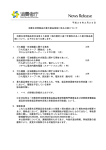
![TECNARE DPA 28X OWNER [Ingles]](http://vs1.manualzilla.com/store/data/005945802_1-b9e6af5d2577bc9a733b6f858960f622-150x150.png)

